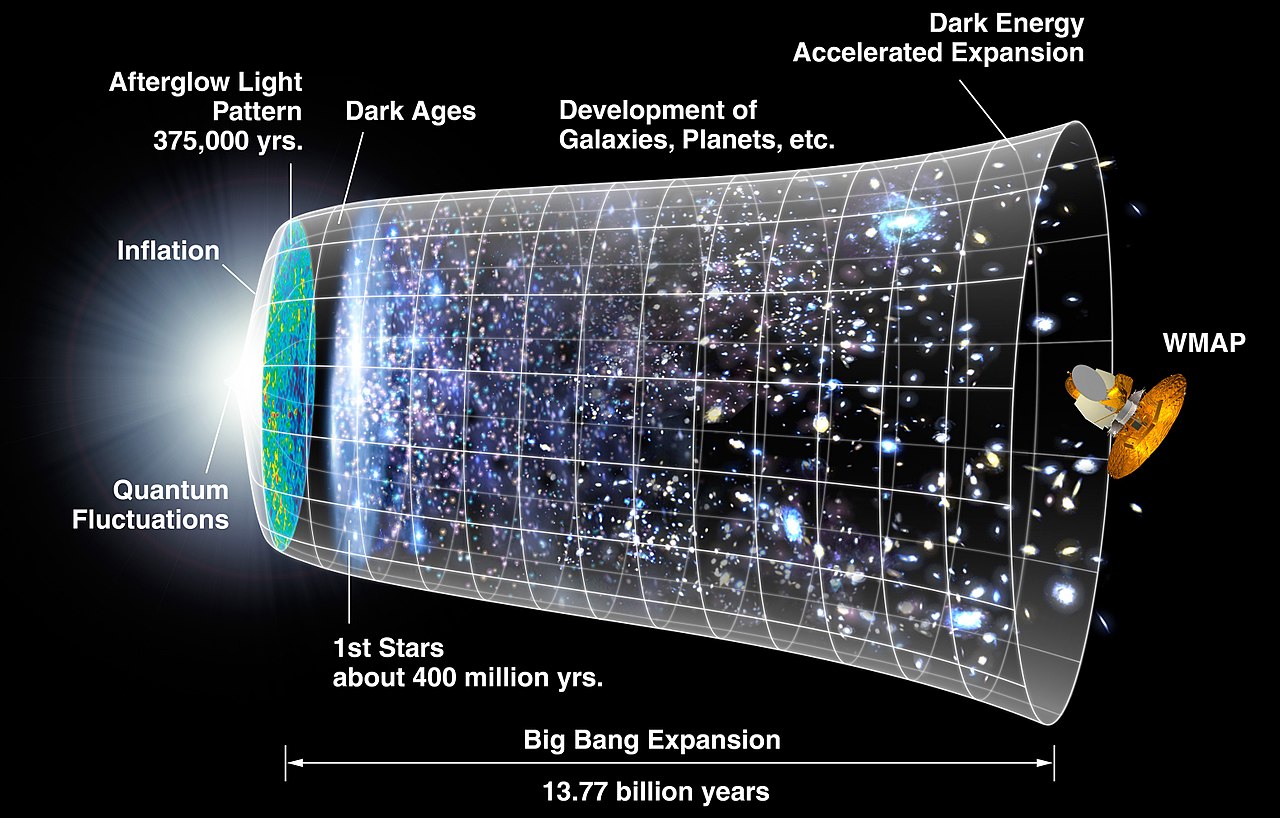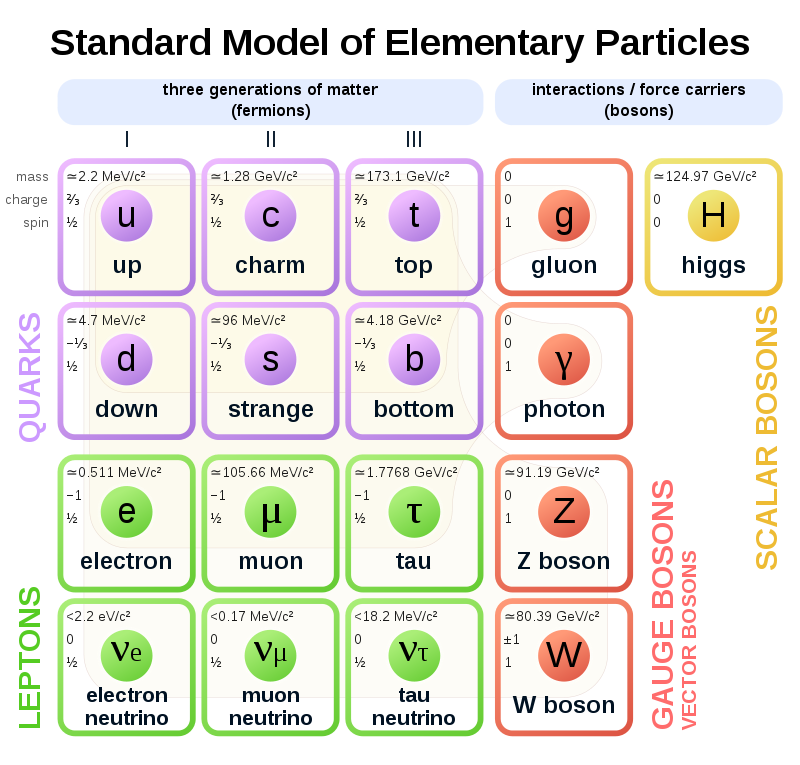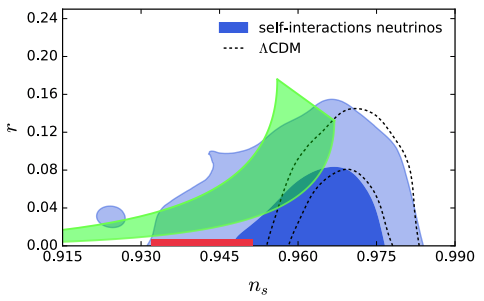Old Models of Cosmic Inflation Resurrected by Neutrinos
By Abhinav Jindal, May 1, 2019
Article: “Inflation meets neutrinos”
Authors: Gabriela Barenboim, Peter B. Denton, Isabel M. Oldengott
Reference: arXiv:1903.02036 [astro-ph.CO]
Inflation? Neutrinos? The former is the rapid expansion of the universe in less than a trillionth of a trillionth of a second after the Big Bang, and the latter are extremely light subatomic particles that can pass through a light-year long block of lead unscathed. At first glance, it’s difficult to imagine how they might be related to each other. However, a recent study concludes that specific models of inflation may have been prematurely discarded by scientists that neglected certain interactions of neutrinos.
A history of inflation

Figure 1: A timeline of the Universe, which has been expanding ever since the moment of the Big Bang. The earliest moments (on the left) show a very rapid expansion, called inflation. Source: NASA via Wikipedia
The vast amount of data collected from observations of the sky indicates that the universe was much hotter and much denser in the past. The Big Bang theory is a model for the expansion of the universe from a single point that explains the various phenomena that scientists have observed. However, there are some peculiarities of the universe that demand a very specific type of expansion early in the universe. First, at large scales, the universe has the same density of matter and temperature throughout, even though separated regions have had no way to physically communicate with each other. Second, the universe has a matter density that is not so high as to cause the universe to collapse under its own gravity, but not so low as to cause it to expand into oblivion. Instead, it has just the right amount of matter that causes the curvature of the universe to be nearly flat. Third, we have not observed any magnetic monopoles, even though they should exist given our current understanding of particle physics. Inflation was introduced to explain these observed phenomena in one fell swoop.
Conceived by theoretical physicist Alan Guth in 1979, inflation refers to a period of exponential expansion of the universe in its earliest moments, from 10-36 to 10-32 seconds after the Big Bang. While we know that the universe has always been expanding, it expanded much more rapidly in this inflationary epoch (see Figure 1). Inflation explains why the universe is homogeneous, flat, and lacks magnetic monopoles (see here for explanations). However, a good scientific theory doesn’t just explain existing phenomenon, it makes new predictions. The theory of inflation has done just this. For example, tiny quantum fluctuations after the Big Bang would be stretched out rapidly by inflation. This has been confirmed by experiments such as WMAP, which occurred decades after inflation was postulated.
Neutrinos: the lightest particles in the universe

Figure 2: A classification of the elementary particles in the Standard Model. Neutrinos are located at the bottom. Source Wikipedia
The fundamental particles in the universe, also called elementary particles, make up all matter and mediate all physical interactions included in the Standard Model (see Figure 2). In their recent study, the authors Gabriela Barenboim, Peter Denton, and Isabel Oldengott focus on neutrinos, named after their neutral charge (neutr-) and light masses (-ino) and denoted as ν. Most of the neutrinos that Earth receives are a byproduct of nuclear reactions that occur at the core of the Sun, but some have cosmological origins. These particles are the lightest known particles (less than 10-36 kg) and very rarely interact with other particles. In fact, hundreds of trillions of them pass through your body every second and completely ignore you! However, with a high enough density or long enough timescales, neutrino interactions can still occur and be measured.
In particular, the authors examine the self-interactions between neutrinos that scatter off the cosmic neutrino background. This background is a source of neutrinos coming from all directions in the sky as a relic from the early universe, when the conditions allowed for neutrinos to disassociate from other particles and stream freely through the universe. It is not known for sure whether these interactions take place, but if they occur then the particle that mediates them (called the majoron) has not been observed yet. However, if they do occur, there are significant implications for cosmology.
Inflation models coming back to life
There are two parameters that cosmologists measure when comparing inflation models with data: the spectral index ns and the tensor-to-scalar ratio r. The spectral index is a number that characterizes how matter density fluctuations in the universe vary over a particular length scale. If density fluctuations are the same regardless of the length scale considered, then ns=1 (it has actually been measured to be slightly below this, perfectly consistent with most inflation models). The tensor-to-scalar ratio is similar, except instead of characterizing matter density fluctuations, it characterizes the gravitational wave fluctuations.

Figure 3: The region bound by the dashed lines show the allowed values for ns and r before the consideration of the new neutrino interactions, while the blue regions show the new regions. In both cases, the inner region is where the authors are 68% confident, while the outer region is where they are 95% confident. The green and red show predictions from inflation models that are consistent with data only when considering self-interacting neutrinos. Source: Figure 3 from the paper.
The important thing to note is that different models for inflation predict different values for these two measurable quantities. By measuring the parameters with actual data, we can confirm which models can persist and which ones should be discarded. When considering the new neutrino interactions, the authors have shown that the data allow for slightly different values for ns and r than previously thought (see Figure 3). Amazingly, models that were previously thought to be ruled out are now actually consistent with the data if neutrinos do indeed self-interact. The authors in this report illustrate two of the more appealing models. One is called “natural inflation”, and the other is called “Coleman-Weinberg inflation”, shown respectively as green and red regions in Figure 3.
Future detection of self-interacting neutrinos
It is still not known whether the scattering of neutrinos off the cosmic neutrino background actually occurs or not. However, neutrinos coming from outside our galaxy can be observed by the IceCube Neutrino Observatory. If IceCube finds a deficit of neutrinos arriving with a particular energy, the same energy required for those self-interactions, then it will be a clear indication that these interactions are real. Curiously enough, the authors note that a small hint of this deficit actually does exist at the appropriate energy of 500 TeV, though this dip is too small to be conclusive.
If indeed the new neutrino interaction is found to exist, we will have to go back and revisit the way we model the behavior of the early universe. Models that were previously thrown away may yet be given a breath of life. Eventually, with further data from IceCube, the curious case of tiny neutrinos affecting our understanding of the universe’s infancy may be solved.


About Abhinav Jindal
I recently graduated with an MSc. in Astronomy & Astrophysics from the University of Toronto. My research has spanned a wide range of topics from exoplanet atmospheres to globular cluster dynamics. Currently, I am studying life sciences as a non-degree student at University of Toronto, hoping to pursue an MD in the near future. I enjoy engaging with the public at various outreach events. In my spare time, I like to play guitar and daydream about the universe.
